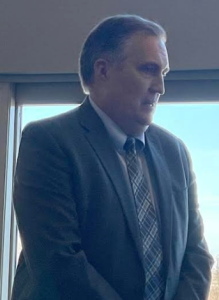By Patricia A. Scheyer
NKyTribune reporter
Officials from the Norfolk Southern railroad and the Northern Kentucky Water Department, as well as from Orsanco, the Ohio River Valley Sanitation Commission came to the Kenton County Mayor’s meeting Saturday morning, at the Independence Senior Center this month. Their mission was to inform the cities about the repercussions of the disaster in Palestine and reassure the cities about the safety procedures in this area.

Derek Sublette, Executive Director of Norfolk Southern, assured that the tracks are safe. (Photos by Patricia Scheyer/NKyTribune)
“We did have to spend about $45 million on granulated activated charcoal,” said Lindsey Rechtin, CPA, President and CEO of the Northern Kentucky Water District. “But we can stand up here confidently today and say, because of that investment, we are in a good place. The drinking water is safe.”
She said they have closed the Ohio River intakes for 12 hours as an extreme precaution just to be safe. In response to a question from Commissioner Jon Draud, she told the group that they can shut the intakes down safely for about two days. She did say that they obtain the majority of their water from the Ohio River, and the Licking River could not adequately supply the area with water.
“We know the path it is following,” added Richard Harrison, Executive Director of Orsanco. “It is moving about 25 miles per day. We take samples every day. We work with our partners, the state agencies, and the USEPA. We saw very early on that this was not a major drinking water threat. We’ve seen zero — zero — amount of this chemical in the drinking water.”
He said they worked with several agencies and found out that the chemical they were mainly concerned with, n-butyl acrylate, is not naturally found in drinking water, so they programmed their computers to detect this chemical. The number for the amount of this chemical in parts per billion should not exceed 560, and Harrison said the highest they detected of the chemical through their certified labs has not exceeded 12 parts per billion.

Richard Harrison, Executive Direcor or ORSANCO talked about the safety of the water.
Harrison explained that the Northern Kentucky Water Department has the granulated activated charcoal system, which he said is an incredible barrier that provides protection well beyond the current regulatory level. This system is what is responsible for barring the chemical from entering into the drinking water, but there are many other filtration systems that they use.
He mentioned that a Fed Ex driver came to his company to deliver a package, and the first thing the driver said was “Can I drink the water?”
“There’s such a misunderstanding about what’s happening with the water supply,” said Harrison.
“But we have been doing this for decades. We are always working on this. We know what to do.”
A new bulletin was released Sunday that the Greater Cincinnati Water Works has decided to keep their intakes closed a little longer because of another chemical, 2-Ethyl-1-hexanol, which has been detected upstream of their intakes.
In addition to the reassuring messages from the water people, Derek Sublette, Executive Director of Government Relations from the Norfolk Southern Railroad, came to talk about the actions that the railroad takes to maintain the safety of their tracks on a daily, weekly and monthly basis.
“I am here today to answer questions generally about what we do everyday,” said Sublette. “The tracks are safe. We inspect them regularly, according to federal rules. We do inspect weekly, and more often in warmer weather.”
Park Hills Mayor Kathy Zembrodt asked if cities are notified ahead of time if hazardous materials
will be traveling through those cities.
“We do not notify the cities,” he said. “Not proactively.”

Lindsey Rechtin, President and CEO of the NKY Water Department, assured the group of the safety of the drinking water.
Ft Wright Mayor Dave Hatter asked if all railroads have ways to protect their tracks from potential terrorists. He said this area has several places where there are bridges and areas that are fairly isolated. He said if four to five cars full of chlorine are derailed and go off a railroad bridge it has a potential of killing a lot of people.
Sublette said it is like protecting the interstate, it is difficult to do every single inch of track. He said they have 20,000 miles of mainline track, and they do have a 22-state network.
“Proactively, the regular inspection of the tracks is the best thing we can do,” he explained. “Norfolk Southern, like other class one larger railroads, does maintain its own police force, and those are constituted by state law. We understand we could become a target but we take safety very seriously and we do as much as we can.”
Sublette said 99.99 percent of freight reaches its destination without incident, and rail is significantly more safe than the alternative of trucks, which is their biggest competitor.
“If you are getting hurt on a railroad its not going to be a papercut,” he said. “I mean, these are big, heavy pieces of equipment, of an industrial nature. So every meeting, wherever it takes place, starts immediately with a safety briefing. It behooves us to be safe.”
Both Harrison and Rectin from the water industry and Sublette from the railroad gave positive messages that seemed to answer all the questions posed by the mayors, and all three promised to keep the lines of communications open for further developments.



















